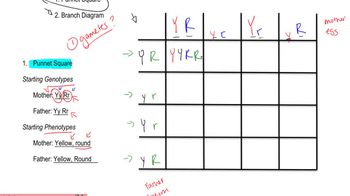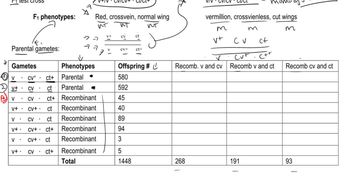Two organisms with the genotypes Aa bb Cc Dd Ee and Aa Bb Cc dd Ee were crossed. Use the branch method to determine the proportion of the following genotypes in the offspring. I. aa bb cc dd ee
Table of contents
- 1. Introduction to Genetics51m
- 2. Mendel's Laws of Inheritance3h 37m
- 3. Extensions to Mendelian Inheritance2h 41m
- 4. Genetic Mapping and Linkage2h 28m
- 5. Genetics of Bacteria and Viruses1h 21m
- 6. Chromosomal Variation1h 48m
- 7. DNA and Chromosome Structure56m
- 8. DNA Replication1h 10m
- 9. Mitosis and Meiosis1h 34m
- 10. Transcription1h 0m
- 11. Translation58m
- 12. Gene Regulation in Prokaryotes1h 19m
- 13. Gene Regulation in Eukaryotes44m
- 14. Genetic Control of Development44m
- 15. Genomes and Genomics1h 50m
- 16. Transposable Elements47m
- 17. Mutation, Repair, and Recombination1h 6m
- 18. Molecular Genetic Tools19m
- 19. Cancer Genetics29m
- 20. Quantitative Genetics1h 26m
- 21. Population Genetics50m
- 22. Evolutionary Genetics29m
2. Mendel's Laws of Inheritance
Dihybrid Cross
Problem 1e
Textbook Question
Compare and contrast the following terms:
Dihybrid cross and Trihybrid cross
 Verified step by step guidance
Verified step by step guidance1
Define a dihybrid cross: A dihybrid cross involves the study of inheritance patterns for two traits, each controlled by different genes. For example, crossing two heterozygous individuals (AaBb) for two traits results in a 4x4 Punnett square with 16 possible genotype combinations.
Define a trihybrid cross: A trihybrid cross involves the study of inheritance patterns for three traits, each controlled by different genes. For example, crossing two heterozygous individuals (AaBbCc) for three traits results in an 8x8 Punnett square with 64 possible genotype combinations.
Compare the complexity: A dihybrid cross is simpler than a trihybrid cross because it involves fewer traits and fewer possible combinations. The Punnett square for a dihybrid cross is smaller (4x4) compared to the larger (8x8) Punnett square for a trihybrid cross.
Contrast the phenotypic ratios: In a dihybrid cross, the phenotypic ratio for two heterozygous parents (AaBb x AaBb) is typically 9:3:3:1 for the four possible phenotypes. In a trihybrid cross, the phenotypic ratio for three heterozygous parents (AaBbCc x AaBbCc) is 27:9:9:9:3:3:3:1 for the eight possible phenotypes.
Explain the genetic principles involved: Both dihybrid and trihybrid crosses rely on Mendel's laws of inheritance, specifically the Law of Independent Assortment, which states that alleles for different genes assort independently of one another during gamete formation. However, the number of traits being studied increases the complexity of the analysis in a trihybrid cross compared to a dihybrid cross.
 Verified video answer for a similar problem:
Verified video answer for a similar problem:This video solution was recommended by our tutors as helpful for the problem above
Video duration:
3mPlay a video:
Was this helpful?
Key Concepts
Here are the essential concepts you must grasp in order to answer the question correctly.
Dihybrid Cross
A dihybrid cross is a genetic cross that examines the inheritance of two different traits, each represented by two alleles. For example, when crossing pea plants that differ in seed shape and color, the resulting offspring can exhibit various combinations of these traits. The phenotypic ratio typically observed in the F2 generation of a dihybrid cross is 9:3:3:1, reflecting the independent assortment of alleles.
Recommended video:
Guided course

Punnet Square
Trihybrid Cross
A trihybrid cross involves the study of three different traits, each with two alleles, in a genetic cross. This type of cross expands the complexity of inheritance patterns, as it considers the interactions among three pairs of alleles. The expected phenotypic ratio in the F2 generation of a trihybrid cross is 27:9:9:9:3:3:3:1, illustrating the principle of independent assortment across multiple traits.
Recommended video:
Guided course

Trihybrid Cross
Independent Assortment
Independent assortment is a fundamental principle of genetics that states that alleles for different traits segregate independently of one another during gamete formation. This means that the inheritance of one trait does not influence the inheritance of another trait. This principle is crucial for understanding the outcomes of both dihybrid and trihybrid crosses, as it allows for the combination of various traits in the offspring.
Recommended video:
Guided course

Gamete Genetics and Independent Assortment
Related Videos
Related Practice
Multiple Choice
951
views
4
rank


